Your roof is a critical component of your home, providing shelter and protection from the elements. Regular roof maintenance is essential to prolong its lifespan, prevent costly repairs, and safeguard your investment. In this blog, we’ll explore key roof maintenance tips to help homeowners maintain a sturdy and reliable roofing system.
- Regular Inspections:
Performing regular roof inspections is the foundation of effective maintenance. Ideally, homeowners should inspect their roofs at least twice a year – in the spring and fall. Look for signs of damage, such as missing or damaged shingles, cracks, and leaks. Binoculars can be a handy tool for a closer examination without having to climb onto the roof. Identifying issues early allows for timely repairs and prevents minor problems from escalating into major concerns.
- Clean Gutters and Downspouts:
Clogged gutters and downspouts can lead to water pooling on the roof, causing damage to shingles, fascia, and even the interior of the home. Regularly clean gutters to remove leaves, debris, and other obstructions. Ensure that downspouts are clear and direct water away from the foundation. Proper drainage is crucial in preventing water damage and maintaining the structural integrity of the roof.
- Trim Overhanging Branches:
Trees near your home can pose a threat to your roof if their branches hang over it. Trim overhanging branches to prevent them from scraping against the roof during storms and windy conditions. Falling leaves and branches can contribute to gutter clogs and create a damp environment that promotes the growth of moss and algae. By keeping trees well-maintained, you reduce the risk of damage to your roof and improve its longevity.
- Address Moss and Algae Growth:
In regions with high humidity, moss and algae growth on roofs can be a common issue. These organisms not only compromise the aesthetic appeal of the roof but can also lead to water retention, accelerating wear and tear. Use a moss-killing solution or a mixture of water and vinegar to clean moss and algae from the roof. Additionally, zinc or copper strips installed at the roof’s peak can help prevent their regrowth.
- Check Flashings and Seals:
Flashings and seals around chimneys, vents, and skylights are susceptible to wear and deterioration over time. Inspect these areas for cracks, gaps, or signs of damage. Ensure that flashings are securely in place, and reseal any areas where the sealant may have worn away. Properly maintained flashings and seals are crucial in preventing water infiltration and maintaining the overall integrity of the roofing system.
- Professional Roof Inspections:
While regular homeowner inspections are valuable, hiring a professional roofing contractor for a comprehensive inspection is equally important. Professionals can identify issues that may not be immediately visible to an untrained eye. Schedule a professional inspection every few years, or more frequently if your area experiences severe weather conditions. Professional assessments provide a thorough understanding of your roof’s condition and help you plan for any necessary repairs or replacements.
Roof maintenance is a proactive approach to preserving the longevity and functionality of one of your home’s most vital components. By incorporating these roof maintenance tips into your routine, you can prevent potential issues, extend the lifespan of your roof, and avoid costly repairs. Remember that a well-maintained roof not only protects your home but also adds value to your property. Regular attention to your roof ensures that it continues to stand strong against the elements, providing comfort and security for years to come.

